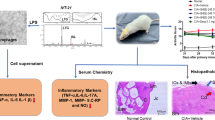Abstract
Verbascum species are widely used in folk medicine because of their broad range of biological activities. Harpagoside, an iridoid glycoside isolated from some Verbascum plants is known for its anti-inflammatory properties. In the present study, the effect of five extracts of Verbascum species and harpagosides were evaluated in mouse models of acute and chronic inflammation. The results demonstrate that Verbascum phoeniceum extract strongly inhibits COX-1 (60.2% inhibition vs PMA-stimulated cells) and COX-2 (44.8% inhibition) expression stimulated peritoneal macrophages resulting in reduced paw swelling in carrageenan-induced oedema (55.5% inhibition vs PBS-treated mice). Harpagoside ameliorated the development of zymosaninduced arthritis and reduced pathological changes in joints as shown by the decreased histological score for cell infiltration in synovial cavity (3.5±0.2 in vs 2.0±0.16), cartilage loss (2.5±0.3 vs 1.8±0.5) and bone resorption (2.4±0.2 vs 1.8±0.4). Molecular docking simulations of harpagoside suggest that it may function with increased specific affinity towards COX-1 than COX-2. The potential of harpagoside to be applied as an effective agent for treating joint-related disorders is discussed.
Similar content being viewed by others
References
Turker A.U., Gurel E., Common mullein (Verbascum thapsus L.): recent advances in research, Phytother. Res., 2005, 19, 733–739
Akkol E.K., Tatli I.I., Akdemir Z.S., Antinociceptive and anti-inflammatory effects of saponin and iridoid glycosides from Verbascum pterocalycinum var. mutense Hub.-Mor, Z. Naturforsch. C, 2007, 62, 813–820
Guarino C., Antimicrobial activity of Verbascum macrurum Ten. (Scrophulariaceae), Bollettino Chimico Farmaceutico, 2002, 141, 238–242
Kupeli E., Tatli I.I., Akdemir Z.S., Yesilada E., Bioassay-guided isolation of anti-inflammatory and antinociceptive glycoterpenoids from the flowers of Verbascum lasianthum Boiss. ex Bentham, J. Ethnopharmacol., 2007, 110, 444–450
Speranza L., Franceschelli S., Pesce M., Menghini L., Patruno A., Vinciguerra I., et al., Antiinflammatory properties of the plant Verbascum mallophorum, J. Biol. Regul. Homeost. Agents, 2009, 23, 189–195
Talib W.H., Mahasneh A.M., Antimicrobial, cytotoxicity and phytochemical screening of Jordanian plants used in traditional medicine, Molecules, 2010, 15, 1811–1824
Tatli I.I., Akdemir Z.S., Yesilada E., Kupeli E., Antiinflammatory and antinociceptive potential of major phenolics from Verbascum salviifolium Boiss, Z. Naturforsch. C, 2008, 63, 196–202
Turker A.U., Camper N.D., Biological activity of common mullein, a medicinal plant, J. Ethnopharmacol., 2002, 82, 117–125
Choy E.H., Panayi G.S., Cytokine pathways and joint inflammation in rheumatoid arthritis, New Engl. J. Med., 2001, 344, 907–916
Stewart K.M., Cole D., The commercial harvest of devil’s claw (Harpagophytum spp.) in southern Africa: the devil’s in the details, J. Ethnopharmacol., 2005, 100, 225–236
Gyurkovska V., Alipieva K., Maciuk A., Dimitrova P., Ivanovska N., Haas C., et al., Anti-inflammatory activity of Devil’s claw in vitro systems and their active constituents, Food Chem., 2011, 125, 171–178
Georgiev M.I., Ludwig-Muller J., Alipieva K., Lippert A., Sonication-assisted Agrobacterium rhizogenes-mediated transformation of Verbascum xanthophoeniceum Griseb. for bioactive metabolite accumulation, Plant Cell Rep., 2011, 30, 859–866
Georgiev M.I., Ali K., Alipieva K., Verpoorte R., Choi Y.H., Metabolic differentiations and classification of Verbascum species by NMR-based metabolomics, Phytochemistry, 2011, 72, 2045–2051
Gehlhaar D.K., Verkhivker G.M., Rejto P.A., Sherman C.J., Fogel D.B., Fogel L.J., et al., Molecular recognition of the inhibitor AG-1343 by HIV-1 protease: conformationally flexible docking by evolutionary programming, Chem. Biol., 1995, 2, 317–324
Lee H.S., Choi J., Kufareva I., Abagyan R., Filikov A., Yang Y., et al., Optimization of high throughput virtual screening by combining shape-matching and docking methods, J. Chem. Inf. Model, 2008, 48, 489–497
Bian Q., Wang Y.J., Liu S.F., Li Y.P., Osteoarthritis: genetic factors, animal models, mechanisms, and therapies, Frontiers Biosci. (Elite Ed), 2012, 4, 74–100
Ristimaki A., Narko K., Hla T., Down-regulation of cytokine-induced cyclo-oxygenase-2 transcript isoforms by dexamethasone: evidence for posttranscriptional regulation, Biochem. J., 1996, 318, 325–331
Hargreaves K., Dubner R., Brown F., Flores C., Joris J., A new and sensitive method for measuring thermal nociception in cutaneous hyperalgesia, Pain, 1988, 32, 77–88
Winter C.A., Risley E.A., Nuss G.W., Carrageenininduced edema in hind paw of the rat as an assay for antiiflammatory drugs, Proc. Soc. Exp. Biol. Medi., 1962, 111, 544–547
Haznagy-Radnai E., Balogh A., Czigle S., Mathe I., Hohmann J., Blazso G., Antiinflammatory Activities of Hungarian Stachys species and Their Iridoids, Phytother. Res., 2012, 26, 505–509
Anauate M.C., Torres L.M., de Mello S.B., Effect of isolated fractions of Harpagophytum procumbens D.C. (devil’s claw) on COX-1, COX-2 activity and nitric oxide production on whole-blood assay, Phytother. Res., 2010, 24, 1365–1369
Author information
Authors and Affiliations
Corresponding author
About this article
Cite this article
Dimitrova, P., Georgiev, M.I., Khan, M.T.H. et al. Evaluation of Verbascum species and harpagoside in models of acute and chronic inflammation. cent.eur.j.biol. 8, 186–194 (2013). https://doi.org/10.2478/s11535-013-0124-2
Received:
Accepted:
Published:
Issue Date:
DOI: https://doi.org/10.2478/s11535-013-0124-2




